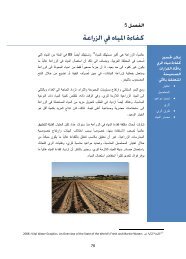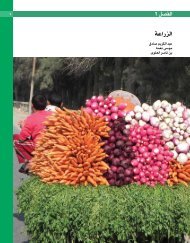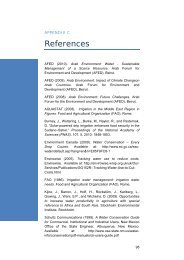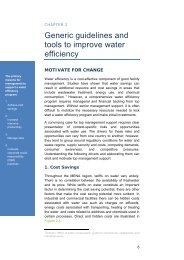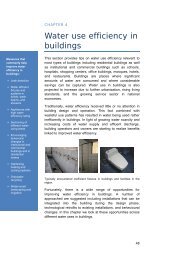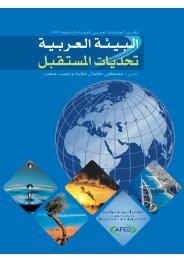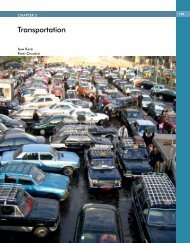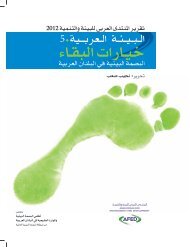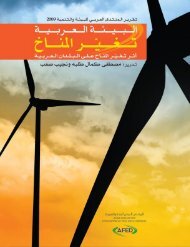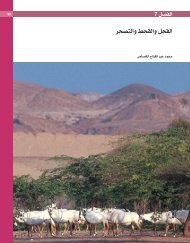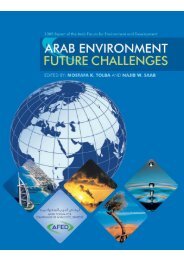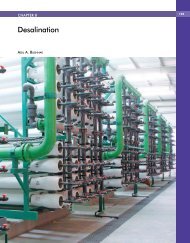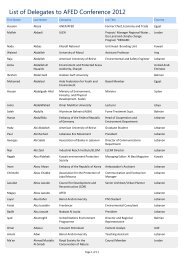Impact of Climate Change on Arab Countries - (IPCC) - Working ...
Impact of Climate Change on Arab Countries - (IPCC) - Working ...
Impact of Climate Change on Arab Countries - (IPCC) - Working ...
Create successful ePaper yourself
Turn your PDF publications into a flip-book with our unique Google optimized e-Paper software.
ARAB ENVIRONMENT: CLIMATE CHANGE 109<br />
TABLE 6<br />
DEGREE OF INFLUENCE ON THE TERRITORIES OF ARAB WORLD<br />
Country Percentage <str<strong>on</strong>g>of</str<strong>on</strong>g> total land area Percentage <str<strong>on</strong>g>of</str<strong>on</strong>g> total land area<br />
(including inland waters) having<br />
(including inland waters) having<br />
very low anthropogenic impact<br />
very high anthropogenic impact<br />
Algeria 84.25 0.58<br />
Bahrain - -<br />
Egypt 86.37 1.85<br />
Iraq 9.51 2.08<br />
Jordan 46.61 1.65<br />
Kuwait 0.05 10.47<br />
Leban<strong>on</strong> 0.0 18.08<br />
Libya 92.46 0.27<br />
Mauritania 93.84 0.02<br />
Morocco 17.90 2.04<br />
Occupied territories - -<br />
Oman 76.24 0.73<br />
Qatar - -<br />
Saudi <strong>Arab</strong>ia 49.24 0.58<br />
Somalia - -<br />
Sudan 44.24 0.11<br />
Syria 0.21 3.10<br />
Tunisia 33.98 3.57<br />
UAE 0.46 5.02<br />
Yemen 49.09 0.17<br />
Source: ESI, 2005<br />
may alter existing competitive interacti<strong>on</strong>s and<br />
influence trophic dynamics with changes in predator-prey<br />
interacti<strong>on</strong>s (Thuiller et al., 2006).<br />
VI. CONCLUDING REMARKS<br />
Agricultural activities and urban envir<strong>on</strong>ment<br />
have high impacts <strong>on</strong> the natural envir<strong>on</strong>ment<br />
and as such the c<strong>on</strong>versi<strong>on</strong> <str<strong>on</strong>g>of</str<strong>on</strong>g> natural vegetati<strong>on</strong><br />
for human activity has important ecological<br />
implicati<strong>on</strong>s. The percentage <str<strong>on</strong>g>of</str<strong>on</strong>g> a country's land<br />
area that has low anthropogenic impact is a measure<br />
<str<strong>on</strong>g>of</str<strong>on</strong>g> the degree to which wild lands that are<br />
important for biodiversity c<strong>on</strong>servati<strong>on</strong> still exist<br />
in that country. The percentage <str<strong>on</strong>g>of</str<strong>on</strong>g> a country's<br />
land area that has high anthropogenic impact is a<br />
measure <str<strong>on</strong>g>of</str<strong>on</strong>g> the degree to which a country's land<br />
area is dominated by high intensity land-uses.<br />
The percentage <str<strong>on</strong>g>of</str<strong>on</strong>g> land impacted by anthropogenic<br />
activity in the <strong>Arab</strong> world has been documented<br />
to be the highest in Leban<strong>on</strong> with<br />
18.08% and Kuwait with 10.47%. Algeria,<br />
Egypt, Libya, Mauritania and Oman have the<br />
highest percentages <str<strong>on</strong>g>of</str<strong>on</strong>g> lands that are <strong>on</strong>ly impacted<br />
by anthropogenic activity to a low degree; the<br />
percentages in these countries are above 70% and<br />
reach as high as 93.84 % and 92.46% respectively<br />
in Mauritania and Libya (Table 6).<br />
The <strong>Arab</strong> world’s acknowledgment <str<strong>on</strong>g>of</str<strong>on</strong>g> the serious<br />
implicati<strong>on</strong>s <str<strong>on</strong>g>of</str<strong>on</strong>g> climate change <strong>on</strong> biodiversity<br />
and the status enjoyed by pro-active initiatives<br />
undertaken can be deciphered by each country’s<br />
nati<strong>on</strong>al reporting to the United Nati<strong>on</strong>s<br />
C<strong>on</strong>venti<strong>on</strong> <strong>on</strong> Biological Diversity (UNCBD).<br />
An analysis <str<strong>on</strong>g>of</str<strong>on</strong>g> two main questi<strong>on</strong>s in the<br />
UNCBD nati<strong>on</strong>al reports reveals a bleak situati<strong>on</strong><br />
into the importance given to this issue and<br />
the acti<strong>on</strong> taken. On the questi<strong>on</strong> dealing with<br />
the implementati<strong>on</strong> <str<strong>on</strong>g>of</str<strong>on</strong>g> projects aimed at mitigating<br />
and adapting to climate change that incorporate<br />
biodiversity c<strong>on</strong>servati<strong>on</strong> and sustainable<br />
use, <strong>on</strong>ly 4 countries have d<strong>on</strong>e so and 5 countries<br />
have such projects under development. The<br />
remaining 11 countries have not undertaken<br />
such projects, have not completed a nati<strong>on</strong>al<br />
report to the CBD, or have not reported anything<br />
<strong>on</strong> this questi<strong>on</strong>.<br />
The sec<strong>on</strong>d questi<strong>on</strong> c<strong>on</strong>cerns countries’ coordinati<strong>on</strong><br />
efforts to ensure that climate change miti-



